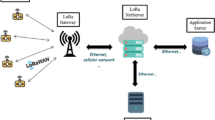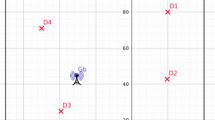Abstract
Long Range Wide Area Network (LoRaWAN) emerges to connect devices that require long-range and low-cost (bandwidth and power) communication services. In this context, the adoption of this technology brings new challenges due to the densification of IoT devices, which causes signal interference and affects the QoS directly. On the other hand, the LoRaWAN transmission configurations’ flexibility allows higher management to use end-device parameters, allowing better resource utilization and improve network scalability. We evaluate an adaptive solution that defines the best LoRaWAN parameter settings to reduce the channel utilization and, consequently, maximize the number of packets delivered. Additionally, to validate the method, we used a mixed-integer linear programming solution and compared the results obtained with those given by the heuristics. The results achieved by the heuristics were very close to those provided by the optimal result, demonstrating the effectiveness of the heuristics.






Similar content being viewed by others
References
Adaptive Data Rate. (2019). https://www.thethingsnetwork.org/docs/lorawan/adaptive-data-rate.html.
Abdelfadeel, K.Q., Cionca, V., & Pesch, D. (2018). Fair adaptive data rate allocation and power control in lorawan. In IEEE 19Th international symposium on” a world of wireless, mobile and multimedia networks”(woWMom) (pp. 14–15). IEEE.
Adelantado, F., & et al (2017). Understanding the limits of loraWAN. IEEE Communications magazine, 55(9), 34–40.
Akpakwu, G.A., et al. (2018). A survey on 5G networks for the Internet of Things: Communication technologies and challenges. IEEE Access, 6, 3619–3647.
Alliance, L. (2015). White paper: A technical overview of LoRa and lora WAN. The LoRa Alliance: San Ramon, CA, USA, pp. 7–11.
Alliance, L. (2017). Lorawan 1.1 regional parameters technical specification.
Amichi, L., et al. (2019). Joint allocation strategies of power and spreading factors with imperfect orthogonality in LoRa Networks. arXiv:1904.11303.
Babaki, J., Rasti, M., & Aslani, R. (2020). Dynamic spreading factor and power allocation of lora networks for dense iot deployments. In 2020 IEEE 31St annual international symposium on personal, indoor and mobile radio communications, pp. 1–6.
Bockelmann, C., et al. (2016). Massive machine-type communications in 5G: physical and MAC-layer solutions. IEEE Communications Magazine, 54(9), 59–65. https://doi.org/10.1109/MCOM.2016.7565189.
Bor, M.C., Roedig, U., Voigt, T., & Alonso, J.M. (2016). Do lora low-power wide-area networks scale?. In Proceedings of the 19th ACM international conference on modeling, analysis and simulation of wireless and mobile systems (pp. 59–67).
Caillouet, C., et al. (2019). Optimal SF Allocation in loraWAN considering physical capture and imperfect orthogonality. In Globecom, 2019.
de Carvalho Silva, J., et al. (2017). LoraWAN – A low power WAN protocol for Internet of Things: A review and opportunities. In 2nd international multidisciplinary conference on computer and energy science (pp. 1–6). IEEE.
Cerwall, P., et al. (2015). Ericsson mobility report. On the Pulse of the Networked Society. Hg. v Ericsson.
Croce, D., et al. (2018). Impact of LoRa imperfect orthogonality: Analysis of link-level performance. IEEE Communications Letters, 22(4), 796–799.
Cuomo, F., Campo, M., Caponi, A., Bianchi, G., Rossini, G., & Pisani, P. (2017). Explora: Extending the performance of lora by suitable spreading factor allocations. In 2017 IEEE 13Th international conference on wireless and mobile computing, networking and communications (wimob) (pp. 1–8). IEEE.
Dawaliby, S., Bradai, A., & Pousset, Y. (2019). Adaptive dynamic network slicing in lora networks. Future Generation Computer Systems, 98, 697–707.
Duda, A., & Heusse, M. (2019). Spatial issues in modeling loraWAN capacity. In ACM MSWIm (pp. 191–198).
El-Aasser, M., Elshabrawy, T., & Ashour, M. (2018). Joint spreading factor and coding rate assignment in lorawan networks. In Global conference on internet of things (GCIot) (pp. 1–7). IEEE.
El Chall, R., Lahoud, S., & El Helou, M. (2019). Lorawan network: Radio propagation models and performance evaluation in various environments in lebanon. IEEE Internet of Things Journal, 6(2), 2366–2378.
Farhad, A., Kim, D.H., & Pyun, J.Y. (2020). Resource allocation to massive internet of things in lorawans. Sensors, 20(9), 2645.
Fernandez-Garcia, R., & Gil, I. (2017). An alternative wearable tracking system based on a Low-Power Wide-Area network. Sensors 17(3).
Henderson, T.R., Lacage, M., Riley, G.F., Dowell, C., & Kopena, J. (2008). Network simulations with the ns-3 simulator. SIGCOMM Demonstration, 14(14), 527.
Kulatunga, C., Shalloo, L., Donnelly, W., Robson, E., & Ivanov, S. (2017). Opportunistic wireless networking for smart dairy farming. IT Professional, 19(2), 16–23.
Lyu, J., Yu, D., & Fu, L. (2019). Achieving Max-Min Throughput in LoRa Networks. arXiv:1904.12300.
Magrin, D., Centenaro, M., & Vangelista, L. (2017). Performance evaluation of lora networks in a smart city scenario. In 2017 IEEE International conference on communications (ICC) (pp. 1–7). ieee.
Matni, N., Moraes, J., Oliveira, H., Rosário, D., & Cerqueira, E. (2020). Lorawan gateway placement model for dynamic internet of things scenarios. Sensors, 20(15), 4336.
Matni, N., Moraes, J., Pacheco, L., Rosário, D., MayOliveira, H., Cerqueira, E., & Neto, A.J.V. (2020). Experimenting long range wide area network in an e-health environment: Discussion and future directions. In Roceedings of the 16th international wireless communications mobile computing conference (IWCMC (p. 2020). Cyprus: Limassol.
Matni, N., Moraes, J., Rosário, D., Cerqueira, E., & Neto, A. (2019). Optimal gateway placement based on fuzzy c-means for low power wide area networks. In 2019 IEEE Latin-american conference on communications (LATINCOM) (pp. 1–6). IEEE.
Mekki, K., Bajic, E., Chaxel, F., & Meyer, F. (2018). A comparative study of lpwan technologies for large-scale iot deployment. South Korea: ICT Express.
Moraes, J., Matni, N., Riker, A., Oliveira, H., Cerqueira, E., Both, C., & Rosário, D. (2020). An Efficient Heuristic loraWAN Adaptive Resource Allocation for IoT Applications. In 25th IEEE symposium on computers and communications (ISCC) (pp. 1–6). IEEE.
Mota, R., Riker, A., & Rosário, D. (2019). Adjusting group communication in dense internet of things networks with heterogeneous energy sources. In Proceedings of the 11th Brazilian Symposium on Ubiquitous and Pervasive Computing. SBC, Porto Alegre, RS, Brasil.
Petajajarvi, J., Mikhaylov, K., Roivainen, A., Hanninen, T., & Pettissalo, M. (2015). On the coverage of lpwans: range evaluation and channel attenuation model for lora technology. In 2015 14th international conference on ITS telecommunications (ITST) (pp. 55–59). IEEE.
Qadir, Q.M., Rashid, T.A., Al-Salihi, N.K., Ismael, B., Kist, A.A., & Zhang, Z. (2018). Low power wide area networks: A survey of enabling technologies, applications and interoperability needs. IEEE Access.
Raza, U., et al. (2017). Low power wide area networks: an overview. IEEE Communication Surveys & Tutorials, 19(2), 855–873.
Sallum, E., Pereira, N., Alves, M., & Santos, M. (2020). Improving quality-of-service in lora low-power wide-area networks through optimized radio resource management. Journal of Sensor and Actuator Networks, 9(1), 10.
Sandoval, R.M., Garcia-Sanchez, A.J., & Garcia-Haro, J. (2019). Optimizing and updating lora communication parameters: a machine learning approach. IEEE Transactions on Network and Service Management, 16 (3), 884–895.
Sandoval, R.M., et al. (2019). Performance optimization of LoRa nodes for the future smart city/industry. EURASIP Journal on Wireless Communications and Networking, 2019(1), 1–13.
Seller, O.B.A. (2017). Wireless communication method. US Patent 9,647,718.
SX1276, L. (2019). 77/78/79 datasheet. Online: http://www.semtech.com/images/datasheet/sx1276.pdf.
Taneja, M., Jalodia, N., Malone, P., Byabazaire, J., Davy, A., & Olariu, C. (2019). Connected cows: Utilizing fog and cloud analytics toward data-driven decisions for smart dairy farming. IEEE Internet of Things Magazine, 2(4), 32–37.
Tran, C., & Misra, S. (2019). The Technical Foundations of IoT. IEEE Wireless Communications, 26(3), 8–8.
Vejlgaard, B., et al. (2017). Interference impact on coverage and capacity for low power wide area IoT networks. In proceedings of the IEEE Wireless Communications and Networking Conference (WCNC 2017) (pp. 1–6). IEEE.
Visconti, P., de Fazio, R., Velázquez, R., Del-Valle-Soto, C., & Giannoccaro, N.I. (2020). Development of sensors-based agri-food traceability system remotely managed by a software platform for optimized farm management. Sensors, 20(13), 3632.
Yegin, A., Kramp, T., Dufour, P., Gupta, R., Soss, R., Hersent, O., Hunt, D., & Sornin, N. (2020). Lorawan protocol: specifications, security, and capabilities. In LPWAN Technologies for iot and m2m applications (pp. 37–63). Elsevier.
Yousuf, A.M., et al. (2018). Throughput, coverage and scalability of LoRa LPWAN for internet of things. In IEEE/ACM 26Th international symposium on quality of service (pp. 1–10).
Zorbas, D., Papadopoulos, G.Z., Maille, P., Montavont, N., & Douligeris, C. (2018). Improving lora network capacity using multiple spreading factor configurations. In proceedings of the 25th International Conference on Telecommunications (ICT 2018) (pp. 516–520).
Acknowledgments
We thank the anonymous reviewers for their valuable comments which helped us improve the quality, content, and presentation of this paper. This study was financed in part by the Coordenação de Aperfeiçoamento de Pessoal de Nível Superior – Brasil (CAPES) – Finance Code 001, and also by the Brazilian National Council for Research and Development (CNPq).
Author information
Authors and Affiliations
Corresponding author
Additional information
Publisher’s Note
Springer Nature remains neutral with regard to jurisdictional claims in published maps and institutional affiliations.
Rights and permissions
About this article
Cite this article
Moraes, J., Oliveira, H., Cerqueira, E. et al. Evaluation of an Adaptive Resource Allocation for LoRaWAN. J Sign Process Syst 94, 65–79 (2022). https://doi.org/10.1007/s11265-021-01678-8
Received:
Revised:
Accepted:
Published:
Issue Date:
DOI: https://doi.org/10.1007/s11265-021-01678-8




